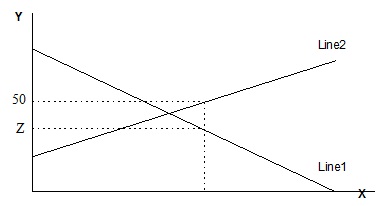Problem 1. Math Review:
1.1 Point A with coordinates (P = 10, Q = 1) and point B with coordinates (P = 5, Q = 11) belong to a straight line. Let P be on the vertical axis and Q on the horizontal axis.
a. Draw a straight line passing through both points.
b. Find the slope of the line.
c. Give the equation of that line.
d. Indicate the vertical and horizontal axis intercepts.
1.2 Suppose that line 1 in the figure below is represented by the equation, Y = 80 – 3X and line 2 in the figure below is represented by the equation, Y = 2X + 20. Find the value of Z.

Problem 2. Positive and Normative Statements:
Identify whether the following statements are normative (N) or positive (P).
2.1 What we need is a government that not only spends -- but spends more wisely.
2.2 The unemployment rate is 5% this year.
2.3 Microeconomics is the study of consumer choice, firms, and markets.
2.4 More women should study for an MBA.
2.5 Society should take measures to end gun violence.
Problem 3. Production possibility frontier:
Besaid Island produces two goods, bicycles and wheat. In the following table, different feasible production combinations are given for Besaid Island. Assume that Besaid Island’s production possibility frontier is linear between combinations A to B, B to C, C to D and D to E.
Combination Bicycles Wheat
A 1,000 0
B 800 800
C 600 1,200
D 300 1,600
E 0 1,800
3.1 Draw Besaid Island’s production possibility frontier with bicycles on the vertical axis and wheat on the horizontal axis.
3.2 If Besaid Island is currently producing at combination C, what is the opportunity cost of producing 400 more units of wheat?
3.3 If Besaid Island is currently producing at combination D, what is the opportunity cost of producing 1 more bicycle?
3.4 Give one example of a production combination that is feasible but not efficient.
3.5 What is the difference between a straight-line production possibility frontier and a bowed-out production possibility frontier in terms of the opportunity cost?
Problem 4. Comparative advantage and Absolute advantage
4.1 What is the definition of comparative advantage?
4.2 What is the definition of absolute advantage?
Bikanel Island and Kilika Island have exactly the same amount of resources to use in the production of wheat and bicycles. Two points describing their production possibility frontiers are given in the following table. Assume that their production possibility frontiers are linear between these two points.
Bikanel Island
Bicycles Wheat
1,000 0
0 2,000
Kilika Island
Bicycles Wheat
500 0
0 250
Let bicycles be on the vertical axis and wheat on the horizontal axis.
4.3 Find the opportunity cost of producing 1 bicycle, both for Bikanel and Kilika Island.
4.4 Find the opportunity cost of producing 1 wheat, both for Bikanel and Kilika Island.
4.5 Relate the results in 4.3 and 4.4 to the slope of Bikanel Island and Kilika Island’s production possibility frontiers.
4.6 Which Island has the absolute advantage in producing bicycles? And which country has the absolute advantage in producing wheat?
4.7 Which Island has the comparative advantage in producing bicycles? And which country has the comparative advantage in producing wheat?